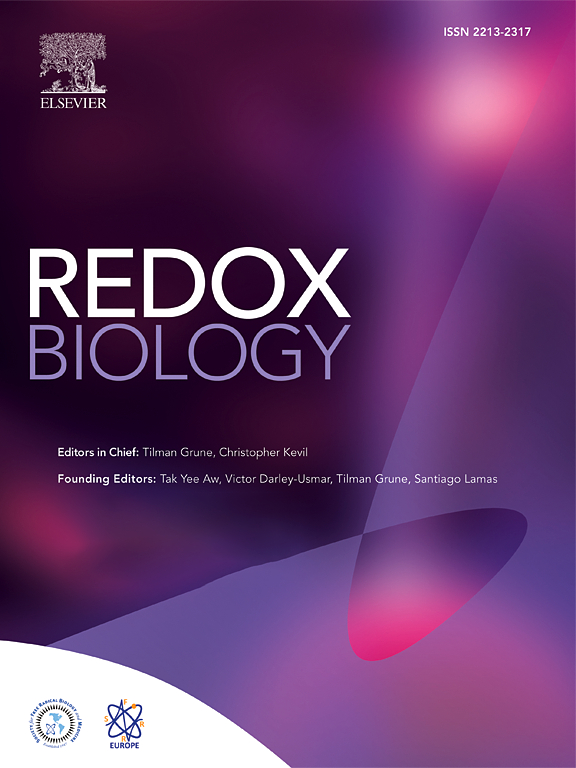羟基酪醇对高血糖诱导的人红细胞磷脂酰丝氨酸暴露的保护作用:关注钙稳态和氧化还原平衡失调
IF 11.9
1区 生物学
Q1 BIOCHEMISTRY & MOLECULAR BIOLOGY
引用次数: 0
摘要
糖尿病是一种广泛存在的慢性疾病,由于其众多相关并发症(包括心血管疾病风险增加)而引起严重的健康问题。在长期高血糖的情况下,红细胞(RBC)经历天然磷脂不对称的破坏,这是由细胞表面暴露于磷脂酰丝氨酸(PS)引发的,与血栓前活性增加有关。本研究的目的是深入了解潜在的分子机制,重点关注两种磷脂转位酶,atp依赖性翻转酶ATP11C和钙依赖性超燃酶PLSCR1。还测试了橄榄油中存在的强效酚类抗氧化剂羟基酪醇(HT)可能发挥的保护作用。将完整的人红细胞暴露于高葡萄糖(25-50 mM)中会导致ps暴露红细胞的剂量依赖性增加,这可以通过低至5 μM的HT来阻止。此外,我们的研究表明,PLSCR1活性在高血糖条件下显着升高。与这一发现一致,免疫细胞化学分析表明该酶的膜表达增加。这两种改变都可以通过高温预处理来预防。相反,没有观察到ATP11C的变化。重要的是,细胞内钙测量显示显著升高,表明钙稳态失调可能是超燃酶活性变化和观察到的高温保护作用的关键机制。事实上,在这种情况下,高温疗法也表现出了保护作用。因此,当细胞暴露于无钙培养基中的高葡萄糖时,没有观察到变化。最后,我们报道HT能够通过减少ROS的形成和细胞内谷胱甘肽的下降来防止葡萄糖诱导的氧化还原平衡的改变,这可能是由于其高清除潜力以及所提出的回收过程循环,可以从其自由基中再生还原型谷胱甘肽。综上所述,我们的研究结果表明RBC是糖尿病相关心血管并发症管理的额外靶点,并表明HT是糖尿病患者预防心血管并发症的营养/营养保健策略。本文章由计算机程序翻译,如有差异,请以英文原文为准。

Protective effect of hydroxytyrosol against hyperglycemia-induced phosphatidylserine exposure in human erythrocytes: focus on dysregulation of calcium homeostasis and redox balance
Diabetes is a widespread chronic disease that poses serious health concerns due to its numerous associated complications, including an increased risk of cardiovascular diseases. Under conditions of prolonged hyperglycemia, erythrocytes (RBC) undergo the breakdown of the natural phospholipid asymmetry, triggered by cell surface exposure of phosphatidylserine (PS) associated with increased prothrombotic activity. The aim of the present study was to provide insights into the potential molecular mechanisms underlying, focusing on two phospholipid translocases, ATP-dependent flippase ATP11C and calcium-dependent scramblase PLSCR1. The possible protective effect exerted by the hydroxytyrosol (HT), a powerful phenolic antioxidant present in olive oil, was also tested. Exposure of intact human RBC to high glucose (25–50 mM) results in a dose-dependent increase in PS-exposing RBC, which can be prevented by HT at concentrations as low as 5 μM. Furthermore, our study reveals that PLSCR1 activity is significantly higher under hyperglycemic conditions. In line with this finding, immunocytochemical analysis indicates increased membrane expression of this enzyme. Both alterations can be prevented by HT pre-treatment. Conversely, no variation in ATP11C is observable. Importantly, intracellular calcium measurement reveals a significant rise, suggesting that dysregulation of calcium homeostasis may be a key mechanism underlying both the change in scramblase activity as well as the HT protective effect observed. In this case too, in fact, HT exhibits a protective effect. Accordingly, when cells are exposed to high glucose in a calcium-free medium no variation is observable. Finally, we report that HT is able to prevent glucose-induced alteration in redox balance by reducing ROS formation and the decline in intracellular glutathione, likely due to its high scavenging potential as well as to the proposed recycling process cycle that could regenerate reduced glutathione from its radical. All together our findings point to RBC as an additional target in the management of the cardiovascular complications associated with diabetes and indicate HT as nutritional/nutraceutical strategy for their prevention in diabetic patients.
求助全文
通过发布文献求助,成功后即可免费获取论文全文。
去求助
来源期刊

Redox Biology
BIOCHEMISTRY & MOLECULAR BIOLOGY-
CiteScore
19.90
自引率
3.50%
发文量
318
审稿时长
25 days
期刊介绍:
Redox Biology is the official journal of the Society for Redox Biology and Medicine and the Society for Free Radical Research-Europe. It is also affiliated with the International Society for Free Radical Research (SFRRI). This journal serves as a platform for publishing pioneering research, innovative methods, and comprehensive review articles in the field of redox biology, encompassing both health and disease.
Redox Biology welcomes various forms of contributions, including research articles (short or full communications), methods, mini-reviews, and commentaries. Through its diverse range of published content, Redox Biology aims to foster advancements and insights in the understanding of redox biology and its implications.
 求助内容:
求助内容: 应助结果提醒方式:
应助结果提醒方式:


